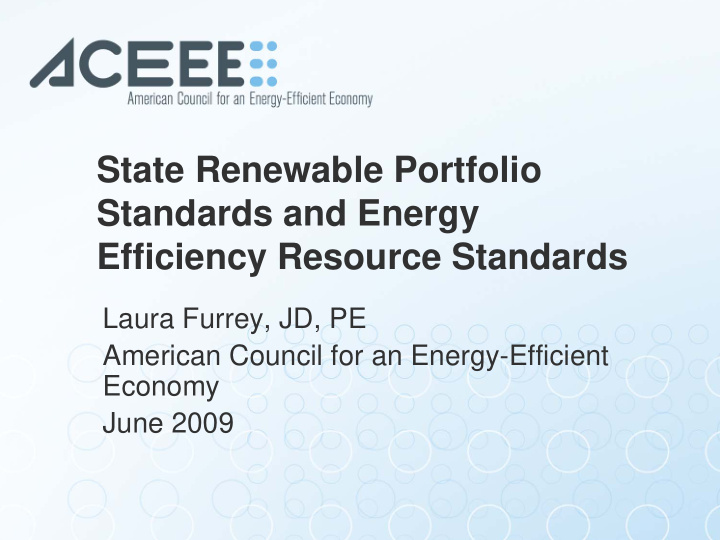



State Renewable Portfolio Standards and Energy Efficiency Resource Standards Laura Furrey, JD, PE American Council for an Energy-Efficient Economy June 2009
The American Council for an Energy-Efficient Economy (ACEEE ) Nonprofit 501(c)(3) dedicated to advancing energy efficiency through research, communications, and conferences. ~35 staff in Washington DC, + field offices in DE, IL, MI, and WI. Focus on End-Use Efficiency in Industry, Buildings, Utilities, and Transportation; Economic Analysis & Human Behavior; and State & National Policy Funding: • Foundations (34%) • Federal & State Grants (7%) • Specific Contract work (21%) • Conferences and Publications (34%) • Contributions and Other (4%)
Renewable Electricity Standards 29 States + D.C. NH: 23.8% by 2025 VT: 10% of 2005 15% by ME: 40% by 2017 sales by 2013 2020 15% by 2015 10% by RI: 16% by 2019 27.4% 2015 MA: 20+% by 2025 20.2% by by 24% 10% by 2025 10% by 10% 2025 CT: 23% by 2020 by 2013 2015 by 2015 NJ: 22.5% by 2020 2015 8% by 2% by MD: 20% by 2022 25% by 12.5% 2020 25% 1999 DE: 20% by 2019 2025 by 2025 by 20% by 16.1% DC: 20% by 2020 20% 2025 20% by 2025 15% by 2020 by VA: 12% by 2022 2020 by 2021 11.2% 2010 by 2021 15% by 16.2% 2025 by 2020 Standard Standard and 5,880 MW (~5.5%) Goal by 2015 Voluntary Goal HI: 20% by 2020 Source: Union of Concerned Scientists 17 states + D.C. have requirements of 20% or higher
State RES Timeline Source: Union of Concerned Scientists, Renewable Electricity Standards Toolkit. 2009.
RES Trends in the Northeast and Mid-Atlantic Region •Northeast and Mid-Atlantic States saw an incremental increase of 1,064 MW in renewable generation between 1998-2007. •NY, PA, and NJ are leading the way in terms of new renewable capacity. •Only ME has consistently hit target. •MA, NY, and CT did not meet targets for different reasons: •MA – shortfall of RECs •NY – budgetary tightening and delayed start dates •CT – unclear resource eligibility Source: Clean Energy States Alliance, Progress Report Review of State Renewable Portfolio Standard Programs in the Northeast & Mid-Atlantic Regions. 2008.
15 states have requirements of 5% or higher Energy Efficiency Resource Standards 19 States
State EERS Timeline 8 PA, NY, MD, OH, NM, MI 7 CO, MN, 6 VA, IL, NC Number of States 5 4 3 CA CT HI NV 2 TX WA VT IA 1 0 1999 2000 2001 2002 2003 2004 2005 2006 2007 2008 2009 Year Source: ACEEE
EERS Trends in Vermont Source: Efficiency Vermont Annual Report Executive Summary. 2008.
RES and EERS are Complementary Policies 10,000 9,000 Current Projected Emissions 8,000 Existing Efficiency 7,000 Opportunities 30% Reduction 6,000 by 2030 Up to an Additional 30% Reduction New Opportunities 5,000 by 2050 4,000 Conservation, 3,000 Renewables, Low-Carbon Energy Sources 2,000 and Other Actions 1,000 Goal: 80% Below 1990 - 1990 1995 2000 2005 2010 2015 2020 2025 2030 2035 2040 2045 2050 Source: Annual Energy Outlook
National Wholesale Electricity Price With an EERS (Climate Framework Scenario) Climate Framework Wholesale Electricity Prices (2006$/MWh) $85 House RES in Climate Framework 10% EE + 5% NG in Climate Framework 15-15 in Climate Framework $80 $75 $70 $65 $60 $55 $50 2020 2025 Source: ACEEE Dec. 2007 EERS-RES study
Current Legislation: Waxman-Markey Bill (H.R. 2454) • 20% Renewable Electricity by 2020 • 25% of RES can be met with Energy Efficiency (total of 5% by 2020) • Eligible 3% for added efficiency if necessary (with petition by Governor) • States can set higher standards and continue to implement state standards (no preemption) • State’s may review and verify savings
Current Legislation: Waxman-Markey Bill (H.R. 2454) Percent of Total Renewable Energy Generation and Energy Efficiency U.S. Sales 500 11.5% 450 9.9% (BAU) 400 350 8.3% Billion kWh 300 250 8.0% 200 6.4% 5.1% (BAU) 150 100 50 0 2012 2013 2014 2015 2016 2017 2018 2019 2020 Business as usual RE (EIA) High RE - (15% RE/5% EE) Low RE - (12% RE/8% EE) Business as usual EE (ACEEE) High EE - (12% RE/8% EE) Low EE - (15% RE/5% EE)
Renewable Energy and Energy Efficiency Require Aggressive, Achievable Goals Energy Efficiency Net Consumer Net Jobs CO2 Emissions Savings by 2020 Savings ($2007) Created Reductions (MMT) 5% $20 billion 26,000 28 8% $46 billion 53,000 52 10% $77 billion 90,000 87 15% $169 billion 220,000 262 Source: ACEEE Internal Analysis Renewable Energy Net Consumer Net Jobs CO2 Emissions Savings by 2020 Savings ($2007) Created Reductions 12% 0 0 0 15% 0 0 0 2% reduction from 25% (by 2025) $64.3 billion 297,000 2009 levels Source: Union of Concerned Scientists, Clean Energy, Green Jobs (2009); Southern Alliance for Clean Energy Internal Analysis
Conclusions • States are leading the way on Renewable Energy and Energy Efficiency. • Not clear that federal proposal will provide significant additional benefit. • Federal RES/EERS needs to be at levels consistent with leading state targets.
For More Information RES • Union of Concerned Scientists http://www.ucsusa.org/clean_energy/solutions/renewable _energy_solutions/ • Southern Alliance for Clean Energy http://www.cleanenergy.org EERS • ACEEE EERS Webpage: www.aceee.org/energy/national/eers.htm • ACEEE State Energy Efficiency Policy Database: http://www.aceee.org/energy/state/index.htm
Recommend
More recommend